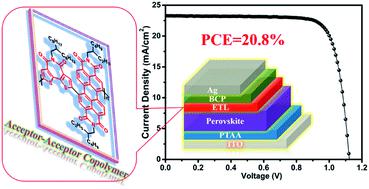当前位置:
X-MOL 学术
›
J. Mater. Chem. A
›
论文详情
Our official English website, www.x-mol.net, welcomes your feedback! (Note: you will need to create a separate account there.)
Imide-functionalized acceptor–acceptor copolymers as efficient electron transport layers for high-performance perovskite solar cells
Journal of Materials Chemistry A ( IF 11.9 ) Pub Date : 2020-06-25 , DOI: 10.1039/d0ta03548c Yongqiang Shi 1, 2, 3, 4, 5 , Wei Chen 1, 2, 3, 4, 5 , Ziang Wu 6, 7, 8, 9, 10 , Yang Wang 1, 2, 3, 4, 5 , Weipeng Sun 1, 2, 3, 4, 5 , Kun Yang 1, 2, 3, 4, 5 , Yumin Tang 1, 2, 3, 4, 5 , Han Young Woo 6, 7, 8, 9, 10 , Ming Zhou 5, 11, 12, 13, 14 , Aleksandra B. Djurišić 15, 16, 17 , Zhubing He 1, 2, 3, 4, 5 , Xugang Guo 1, 2, 3, 4, 5
Journal of Materials Chemistry A ( IF 11.9 ) Pub Date : 2020-06-25 , DOI: 10.1039/d0ta03548c Yongqiang Shi 1, 2, 3, 4, 5 , Wei Chen 1, 2, 3, 4, 5 , Ziang Wu 6, 7, 8, 9, 10 , Yang Wang 1, 2, 3, 4, 5 , Weipeng Sun 1, 2, 3, 4, 5 , Kun Yang 1, 2, 3, 4, 5 , Yumin Tang 1, 2, 3, 4, 5 , Han Young Woo 6, 7, 8, 9, 10 , Ming Zhou 5, 11, 12, 13, 14 , Aleksandra B. Djurišić 15, 16, 17 , Zhubing He 1, 2, 3, 4, 5 , Xugang Guo 1, 2, 3, 4, 5
Affiliation

|
Electron transport layers (ETLs) are critical for improving device performance and stability of perovskite solar cells (PVSCs). Herein, a distannylated electron-deficient bithiophene imide (BTI-Tin) is synthesized, which enables us to access structurally novel acceptor–acceptor (A–A) type polymers. Polymerizing BTI-Tin with dibrominated naphthalene diimide (NDI-Br) and perylene diimide (PDI-Br) affords two A–A copolymers P(BTI-NDI) and P(BTI-PDI). The all-acceptor backbone yields both low-lying highest occupied molecular orbital (HOMO) and lowest unoccupied molecular orbital (LUMO) energy levels for the polymers, which combined with their high electron mobility render P(BTI-NDI) and P(BTI-PDI) as promising ETLs for perovskite solar cells (PVSCs). When applied as ETLs to replace the conventional [6,6]-phenyl-C61-butyric acid methyl ester (PC61BM) in planar p–i–n PVSCs, the PC61BM-free devices based on P(BTI-NDI) and P(BTI-PDI) achieve remarkable power conversion efficiencies (PCEs) of 19.5% and 20.8%, respectively, with negligible hysteresis. Such performance is attributed to efficient electron extraction and reduced charge recombination. Moreover, the devices based on P(BTI-NDI) and P(BTI-PDI) ETLs show improved stability compared to the PC61BM based ones due to the higher hydrophobicity of the new ETLs. This work provides important guidelines for designing n-type polymers to replace PC61BM as efficient ETLs for high-performance PVSCs with improved stability.
中文翻译:

酰亚胺官能化的受体-受体共聚物可作为高性能钙钛矿太阳能电池的有效电子传输层
电子传输层(ETL)对于改善钙钛矿型太阳能电池(PVSC)的性能和稳定性至关重要。在这里,合成了一个脱甲酰化的缺电子联噻吩亚胺(BTI-Tin),这使我们能够使用结构新颖的受体-受体(AA)类型的聚合物。将BTI-Tin与二溴化萘二酰亚胺(NDI-Br)和per二酰亚胺(PDI-Br)聚合,可得到两种A–A共聚物P(BTI-NDI)和P(BTI-PDI)。全受体主链可为聚合物产生低位的最高占据分子轨道(HOMO)和最低的未占据分子轨道(LUMO)能级,再加上它们的高电子迁移率使P(BTI-NDI)和P(BTI- PDI)作为钙钛矿太阳能电池(PVSC)的有前途的ETL。当用作ETL来代替常规[6,6]-苯基-C 61时平面p–i–n PVSC中使用聚丁酸甲酯(PC 61 BM),基于P(BTI-NDI)和P(BTI-PDI)的无PC 61装置实现了显着的功率转换效率(PCE)。磁滞可以忽略不计,分别为19.5%和20.8%。这种性能归因于有效的电子提取和减少的电荷复合。此外,与基于PC 61 BM的设备相比,基于P(BTI-NDI)和P(BTI-PDI)ETL的设备显示出更高的稳定性,这是由于新ETL的疏水性更高。这项工作为设计n型聚合物以取代PC 61 BM作为具有改进稳定性的高性能PVSC的有效ETL提供了重要指导。
更新日期:2020-07-14
中文翻译:

酰亚胺官能化的受体-受体共聚物可作为高性能钙钛矿太阳能电池的有效电子传输层
电子传输层(ETL)对于改善钙钛矿型太阳能电池(PVSC)的性能和稳定性至关重要。在这里,合成了一个脱甲酰化的缺电子联噻吩亚胺(BTI-Tin),这使我们能够使用结构新颖的受体-受体(AA)类型的聚合物。将BTI-Tin与二溴化萘二酰亚胺(NDI-Br)和per二酰亚胺(PDI-Br)聚合,可得到两种A–A共聚物P(BTI-NDI)和P(BTI-PDI)。全受体主链可为聚合物产生低位的最高占据分子轨道(HOMO)和最低的未占据分子轨道(LUMO)能级,再加上它们的高电子迁移率使P(BTI-NDI)和P(BTI- PDI)作为钙钛矿太阳能电池(PVSC)的有前途的ETL。当用作ETL来代替常规[6,6]-苯基-C 61时平面p–i–n PVSC中使用聚丁酸甲酯(PC 61 BM),基于P(BTI-NDI)和P(BTI-PDI)的无PC 61装置实现了显着的功率转换效率(PCE)。磁滞可以忽略不计,分别为19.5%和20.8%。这种性能归因于有效的电子提取和减少的电荷复合。此外,与基于PC 61 BM的设备相比,基于P(BTI-NDI)和P(BTI-PDI)ETL的设备显示出更高的稳定性,这是由于新ETL的疏水性更高。这项工作为设计n型聚合物以取代PC 61 BM作为具有改进稳定性的高性能PVSC的有效ETL提供了重要指导。



























 京公网安备 11010802027423号
京公网安备 11010802027423号